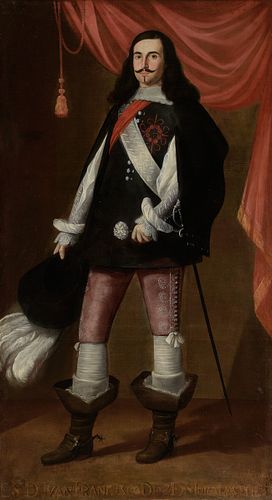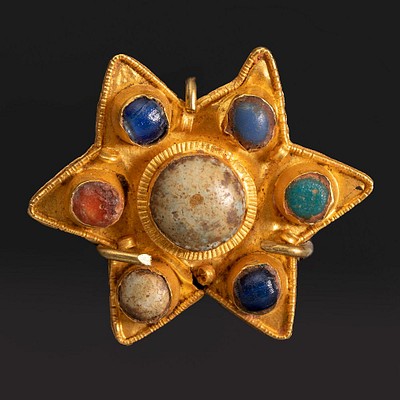ALFARO Y GÓMEZ, Juan de (1643-1680). "Portrait of a gentleman. Oil on canvas.
Lot 82
About Seller
Setdart Auction House
Carrer Aragó 346
Barcelona
Spain
Setdart Subastas was born in 2004 and is currently the first online art auction in Spain with solidity, prestige and reliability guaranteed by our more than 60,000 users. Setdart has a young, dynamic and enterprising team ready to successfully manage the purchase and sale of art works through custom...Read more
Estimate:
EUR€20,000 - EUR€25,000
$21,505.38 - $26,881.72
Absentee vs Live bid
Two ways to bid:
- Leave a max absentee bid and the platform will bid on your behalf up to your maximum bid during the live auction.
- Bid live during the auction and your bids will be submitted real-time to the auctioneer.
Bid Increments
| Price | Bid Increment |
|---|---|
| EUR€0 | EUR€10 |
| EUR€200 | EUR€25 |
| EUR€500 | EUR€50 |
| EUR€1,000 | EUR€100 |
| EUR€3,000 | EUR€200 |
| EUR€5,000 | EUR€500 |
| EUR€10,000 | EUR€1,000 |
| EUR€20,000 | EUR€2,000 |
| EUR€50,000 | EUR€5,000 |
About Auction
By Setdart Auction House
Dec 21, 2021
Set Reminder
2021-12-21 07:30:00
2021-12-21 07:30:00
America/New_York
Bidsquare
Bidsquare : Córdoba: 2,000 Years of Art
https://www.bidsquare.com/auctions/setdart-auction-house/c-rdoba-2-000-years-of-art-8049
Setdart Auction House sofia@setdart.com
Setdart Auction House sofia@setdart.com
- Lot Description
ALFARO Y GÓMEZ, Juan de (1643-1680). "Portrait of a gentleman. Oil on canvas. Frame of the eighteenth century. Measurements: 193.5 x 107.5 cm; 207 x 119 cm (frame). On a neutral background and a surface that almost merges with it, highlighted with a red curtain, stands the figure of a gentleman. His boots, pants, coat, ribbons of military recognition, the cross of the Order of Calatrava on his chest, hairstyle, cape and hat with feathers as they correspond to the fashion of the second half of the seventeenth century, approximately, with the black color predominating in the clothes as the main detail of luxury, along with embroidery and silk. The magnificent drawing that the work shows dominates over the color, as, on the other hand, is usual both at the time and in portraits as a general rule. The detail of the drapery distances the painting a little from the common type of portraits in the Spanish court environment of the Habsburgs, and is much more reminiscent of French examples, much more given to this type of luxury elements. The posture of the personage, the colors, the style, the composition, the use of the neutral background for the portrait, etc., relate the work to Diego Rodríguez da Silva and Velázquez, or, more specifically, to a member of his workshop. It differs from the master in several details, too: note the presence of the shadow in the work, the author does not denote the mastery of Diego de Silva, nor is it the same palette of the master, nor the same lighting he chooses in his portraits (compare the work with, for example, "The Venerable Mother Jerónima de la Fuente" of 1620 and preserved in the Museo del Prado; the "Portrait of the Infante Don Carlos" from between 1626 and 1627 in the same museum; or the painting of "Aesop", from around 1640, and also in this Madrid museum; or the portrait of "Don Pedro de Barberana y Aparregui", painted around 1631-1633 and today in the Kimbell Art Museum in Forth Worth, Texas, United States). Although it is less common than its absence, Velázquez also used the resource of placing a red cloth to highlight the image (portrait of "The Infanta Margarita of Austria", painted in 1660 by Velázquez and finished by his son-in-law Juan Bautista Martínez del Mazo, now in the Museo del Prado). Its realization has been linked to a member of the same, called Juan de Gómez y Alfaro, and with his "Portrait of Don Bernabé Ochoa de Chinchetru", painted in 1661 and preserved in the Museum of Fine Arts of Cordoba, the present painting can be related: the posture of the characters is similar, with their hands "busy" and their gaze directed directly at the viewer, and both have the addition of a rich red cloth in the upper right corner; in this painting, however, the friar's armchair on whose back Bernabé rests his hand is missing, which links this work to the court portraits of the Habsburgs. Juan de Gómez y Alfaro was the son of a noble apothecary, and learned painting from the Cordovan Antonio del Castillo, as well as being a protégé of Antonio Palomino, who sent him to Madrid with letters of recommendation to work in Velázquez's workshop. In the environment of the Royal Collections he got to know and became fond of the painting of Anton Van Dyck, whose style and novelties he introduced in his native Cordoba when he returned. He was Notary of the Holy Office, Administrator of Royal Revenues and painter of the Admiral of Castile (Juan Gaspar Enriquez de Cabrera), and known and appreciated above all for his portraits, of which he painted a considerable number both in Cordoba and in Madrid. His paintings are preserved in important private collections and institutions such as the Museum of Fine Arts of Cordoba, a Baptism of Christ for the Sanctuary of Our Lady of Linares, an "Assumption of the Virgin", painted in 1668, which is in the Museo Nacional del Prado, Madrid.
- Shipping Info
-
In-house shipping available. Please inquire at admin@setdart.com.
-
- Buyer's Premium



 EUR
EUR CAD
CAD AUD
AUD GBP
GBP MXN
MXN HKD
HKD CNY
CNY MYR
MYR SEK
SEK SGD
SGD CHF
CHF THB
THB
















